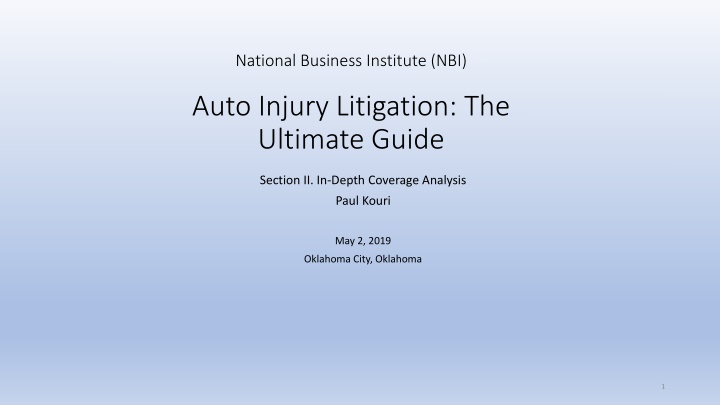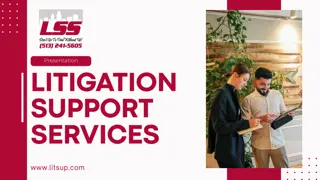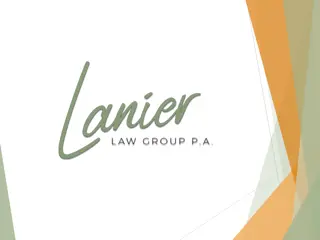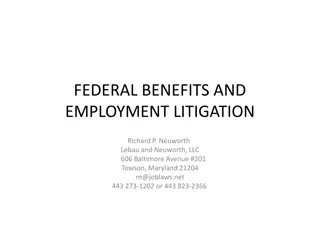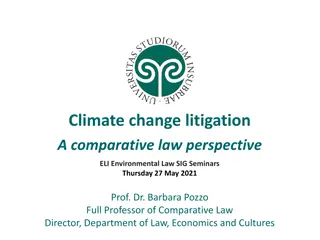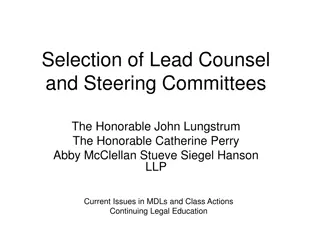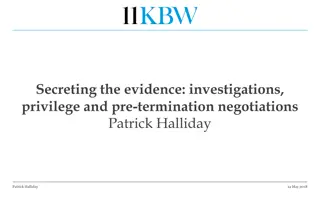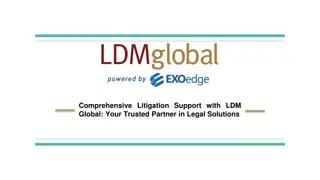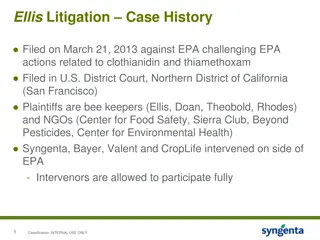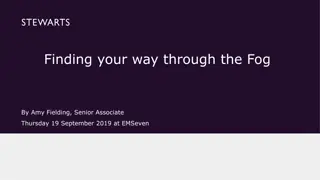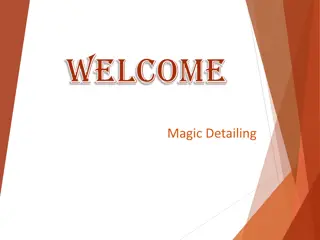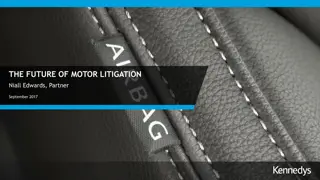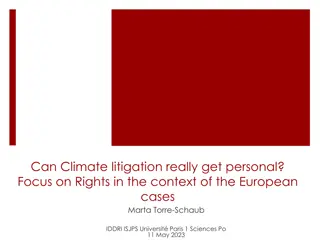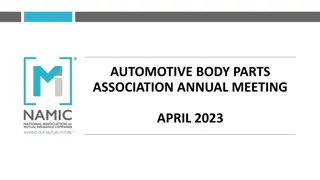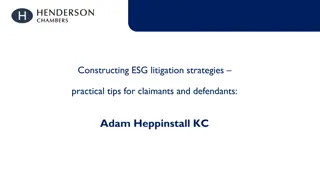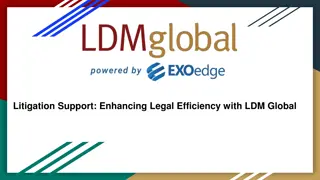Comprehensive Guide to Auto Injury Litigation: NBI Section II Analysis
This detailed guide delves into the intricate coverage analysis of auto injury litigation, highlighting important legal principles and court precedents. It covers topics such as third-party rights under insurance contracts, ambiguity in insurance policy language, and the application of the reasonable expectations doctrine. The guide emphasizes how interpretations of insurance contracts can impact coverage outcomes and legal enforcement in federal courts.
Download Presentation

Please find below an Image/Link to download the presentation.
The content on the website is provided AS IS for your information and personal use only. It may not be sold, licensed, or shared on other websites without obtaining consent from the author.If you encounter any issues during the download, it is possible that the publisher has removed the file from their server.
You are allowed to download the files provided on this website for personal or commercial use, subject to the condition that they are used lawfully. All files are the property of their respective owners.
The content on the website is provided AS IS for your information and personal use only. It may not be sold, licensed, or shared on other websites without obtaining consent from the author.
E N D
Presentation Transcript
National Business Institute (NBI) Auto Injury Litigation: The Ultimate Guide Section II. In-Depth Coverage Analysis Paul Kouri May 2, 2019 Oklahoma City, Oklahoma 1
DECLARATIONS PAGES DECLARATIONS PAGES
Third-party rights under insurance contract Zahn v. General Ins. Co. of America, 1980 OK 79, 611 P.2d 645
In Federal Court this vested right may be enforced by third-party in declaratory judgment action. See, e.g., United Services Auto. Ass'n v. Royal-Globe Ins. Co., 511 F.2d 1094 (10th Cir., 1975)(not really right to enforce contract, but seeking a declaration of the relative rights of the parties No so in Oklahoma Court. Knight ex rel. Ellis v. Miller, 195 P.3d 372, 2008 OK 81
Ambiguity We find that the reasonable expectations doctrine may apply to the construction of ambiguous insurance contracts or to contracts containing exclusions which are masked by technical or obscure language or which are hidden in policy provisions. Max True Plastering Co. v. U.S. Fid. & Guar. Co., 1996 OK 28, 912 P.2d 861, 863.
Ambiguity Under the doctrine, if the insurer or its agent creates a reasonable expectation of coverage [by] the insured which is not supported by policy language, [that] expectation will prevail over the language of the policy. Max True Plastering Co. v. U.S. Fid. & Guar. Co., 1996 OK 28, 912 P.2d 861, 864
Ambiguity A policy term is ambiguous under the reasonable expectations doctrine [or under any doctrine] if it is reasonably susceptible to more than one meaning. When defining a term found in an insurance contract, the language is given the meaning understood by a person of ordinary intelligence. Max True Plastering Co. v. U.S. Fid. & Guar. Co., 1996 OK 28, 912 P.2d 861, 869
Manchester v. OMAG Firefighter ran motorcycle off the roadway, ultimately losing leg. Had health insurance with a municipal association We argued they were insurance Denied coverage (about $500,000 in billing) because he had been drinking before driving (DUI charges had been dropped) and was likely speeding
Manchester v. OMAG Policy excluded coverage for:
Rules of Policy Construction Words of coverage inclusion are broadly construed in favor of coverage while words of exclusion are strictly construed against the insurance company. Max True Plastering Co. v. U.S. Fid. & Guar. Co., 1996 OK 28, 912 P.2d 861, 869
There was no language defining the exclusion Plan argued illegal act and crime were broad terms and included driving after drinking and speeding
Ejusdem generis We argued general terms like crime and illegal act read in light of more descriptive terms: felonious act Aggravated assault
Structural versus Factual Ambiguity (conveniently in the same exclusion)
Claimed beating by licensed counselor Case involved counselor who allegedly spanked some of his underage counselees
Then followed exclusions a.-v., all but one of which started with Arising out of . . .
Such we had, for instance: This insurance does not apply to claims or suits for damages: a. Arising out of an occupation . . . other than [that] specified in the Declarations;
But when we got to the pertinent exclusion, we had this: This insurance does not apply to claims or suits for damages: u. Physical abuse, sexual abuse or licentious, immoral or sexual behavior whether or not intended to lead to, or culminating in any sexual act, whether caused by, or at the instigation of, or at the direction of, or omission by any of you. However, we will defend any civil suit against you seeking amounts that would be covered if this exclusion did not apply. In such case, we will only pay fees, costs and expenses of such defense. Our duty to defend will cease upon admission of guilt by you, or if you are adjudicated guilty or liable. We will have no obligation to appeal any such judgment or adjudication;
Put the exclusion with the lead-in language and we had this: This insurance does not apply to claims or suits for damages: Physical abuse . . . . Can we agree this has no meaning?
This insurance does not apply to claims Physical abuse . . . . claims or suits suits for damages damages: First problem: it s incomprehensible (doesn t that sound so much better than incomplete sentence )
This insurance does not apply to claims Physical abuse . . . . claims or suits suits for damages damages: First problem: it s incomprehensible (doesn t that sound so much better than incomplete sentence ) This is our structural ambiguity
This insurance does not apply to claims Physical abuse . . . . claims or suits suits for damages damages:
This insurance does not apply to claims Physical abuse . . . . claims or suits suits for damages damages: Problem two: it lacks the arising from language: Courts have interpreted arising from very broadly to include any claim in any way tangentially related to the excluded act. E.g., Federal Ins. Co. v. Tri-State Ins. Co., 157 F.3d 800 (10th Cir. 1998). Very tough language to get around.
This insurance does not apply to claims Physical abuse . . . . claims or suits suits for damages damages:
This insurance does not apply to claims Physical abuse . . . . claims or suits suits for damages damages: Factual ambiguity
This insurance does not apply to claims Physical abuse . . . . claims or suits suits for damages damages: structurally ambiguous factually ambiguous
Ambiguity in the Application Process This case involved a life insurance policy purchased by the insured online while in the hospital.
Facts: Applicant was in hospital at time of application undergoing testing for flank pain Physicians strongly suspected cancer but had not made firm diagnosis Policy was issued Diagnosis confirmed Insured died from the cancer less than two years after policy issue
36 O.S. Section 4004 (life insurance only) There shall be a provision that the policy (exclusive of provisions relating to disability benefits or to additional benefits in the event of death by accident or accidental means) shall be incontestable, except for nonpayment of premiums, after it has been in force during the lifetime of the insured for a period of two (2) years from its date of issue. So, by statute, life insurance company must rescind for misrepresentation in application within 2 years of policy issue
And statements in application are deemed representations not warranties : This becomes important as it renders an interesting interpretation of the misrepresentation statute.
36 O.S. Section 3609: A. All statements and descriptions in any application for an insurance policy or in negotiations therefor, by or in behalf of the insured, shall be deemed to be representations and not warranties. Misrepresentations, omissions, concealment of facts, and incorrect statements shall not prevent a recovery under the policy unless: 1. Fraudulent; or 2. Material either to the acceptance of the risk, or to the hazard assumed by the insurer; or 3. The insurer in good faith would either not have issued the policy, or would not have issued a policy in as large an amount, or would not have provided coverage with respect to the hazard resulting in the loss, if the true facts had been made known to the insurer as required either by the application for the policy or otherwise
CASELAW ON 36 O.S. Section 3609 READS OR IN CONJUNCTIVE: Misrepresentations, omissions, concealment of facts, and incorrect statements shall not prevent a recovery under the policy unless: 1. Fraudulent; AND 2. Material either to the acceptance of the risk, or to the hazard assumed by the insurer; AND 3. The insurer in good faith would either not have issued the policy, or would not have issued a policy in as large an amount, or would not have provided coverage with respect to the hazard resulting in the loss, if the true facts had been made known to the insurer as required either by the application for the policy or otherwise
e.g., Claborn v. Washington National Ins. Co., 910 P.2d 1046, 1996 OK 8 in order for an insurer to escape liability under this section for misrepresentation in the application process, the insurer bears the burden of proof to show not only that the statements were untrue, but also that the misrepresentations were either fraudulent, material to the risks or hazards assumed by the insurer, and, in good faith, the insurer would not have issued the policy, or covered the hazard if the true facts had been known in the application. Failure to disclose a latent condition of which the person making application has no knowledge or reason to know does not constitute a defense to an action on the policy. Claborn v. Washington National Ins. Co., 910 P.2d 1046, 1996 OK 8 (Okla., 1996)
Hays v. Jackson National Life Ins. Co., 105 F.3d 583 (10th Cir., 1997): This interpretation is expressly set out in 10th Circuit cases noted Oklahoma Court interprets this way. We find the dispositive whether section 3609 requires Jackson National to prove that Mr. Hays provided his application answers with an intent to deceive. We begin with the language of the statute. As the district court noted, there is a disjunction between subparagraphs (A)(1) and (A)(2)--the statute refers to misrepresentations and omissions that are fraudulent or material. This might suggest that the insured's state of mind is irrelevant, so long as the misrepresented or omitted information is material to the insurer's decision. Subparagraphs (A)(1) and (A)(2), However . . . In Massachusetts Mutual Life Insurance Co. v. Allen, 416 P.2d 935 (Okla.1965), the insurer sought to cancel a life insurance policy based on the fact that the insured did not disclose on the application that he had had a lymph node removed for diagnostic tests. The insured defended by arguing that he had not considered the biopsy serious In affirming a verdict for the insured, the court quoted the following definition of "misrepresentation : A misrepresentation in insurance is a statement as a fact of something which is untrue, and which the insured states with the knowledge that it is untrue and with an intent to deceive, or which he states positively as true without knowing it to be true, and which has a tendency to mislead, where such fact in either case is material to the risk. Hays v. Jackson National Life Ins. Co., 105 F.3d 583 (10th Cir., 1997)
A. All statements and descriptions in any application for an insurance policy or in negotiations therefor, by or in behalf of the insured, shall be deemed to be representations and not warranties
15 O.S. Section 235 Rescission, when not effected by consent, can be accomplished only by the use, on the part of the party rescinding, of reasonable diligence to comply with the following rules: 1. He must rescind promptly, upon discovering the facts which entitle him to rescind, if he is free from duress, menace, undue influence, or disability, and is aware of his right to rescind; and, 2. He must restore to the other party everything of value which he has received from him under the contract; or must offer to restore the same, upon condition that such party shall do likewise, unless the latter is unable, or positively refuses to do so.
